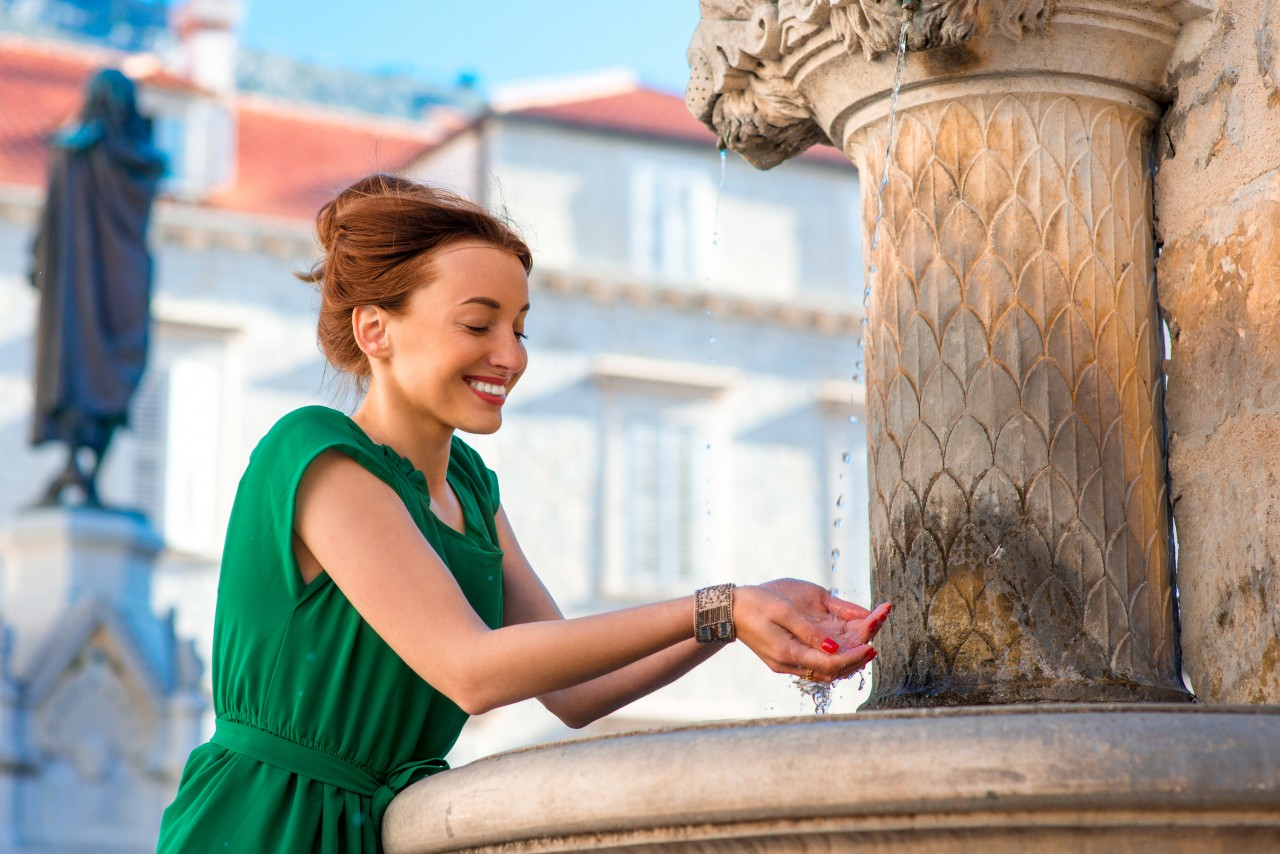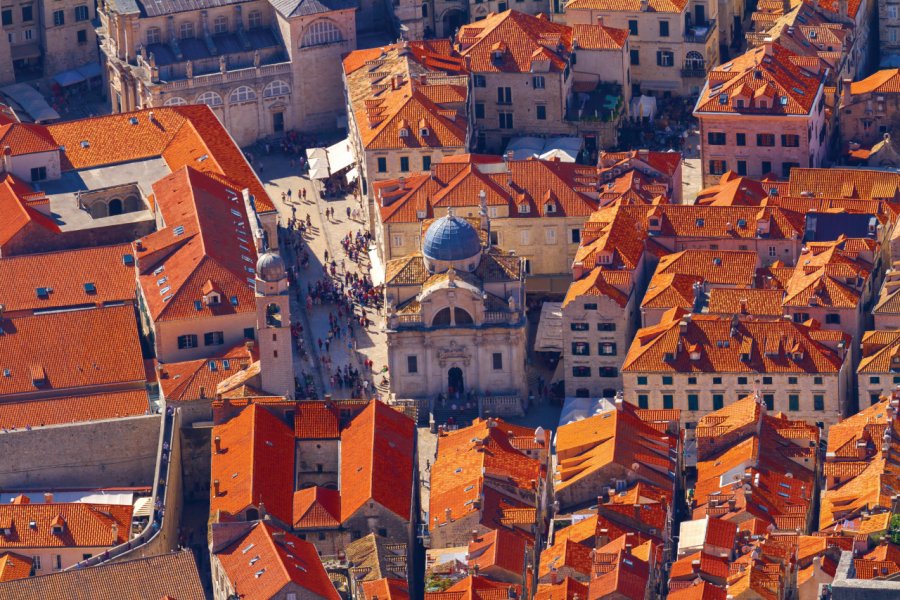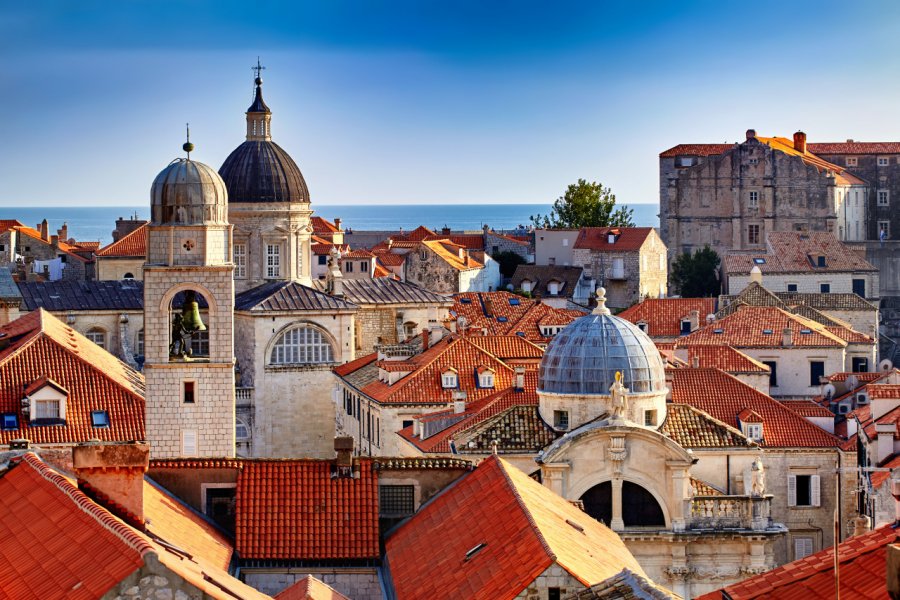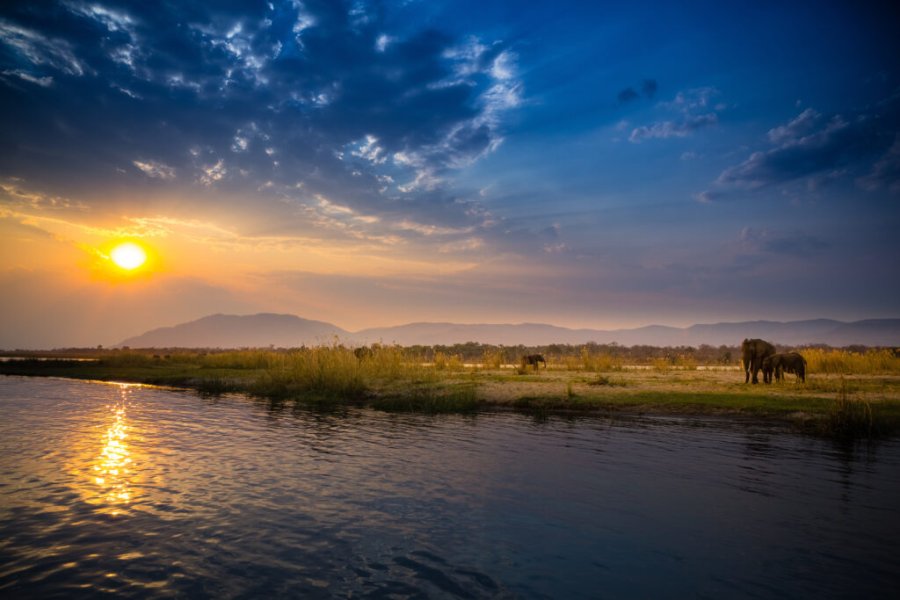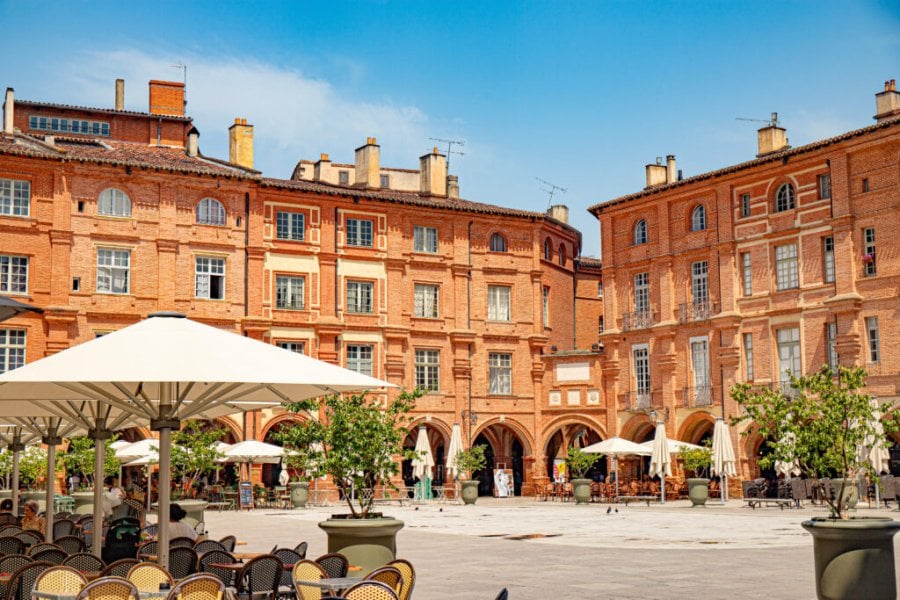A long weekend in Dubrovnik
Highlights of the trip
During your stay you can enjoy the following highlights: Culture / Heritage, Discovery, Free time, Relaxation / Well-being.
Best times to go
The best time(s) to go is/are : Printemps, Eté.
The map of your stay "A long weekend in Dubrovnik"
Detail of the stay : A long weekend in Dubrovnik
How to get there
Discovery and walk of the ramparts

Steps: Dubrovnik
Enter the old city of Dubrovnik through the Pile Gate. This impressive stone door with a drawbridge is overlooked by a statue of Saint Blaise, the protector of the city. The current (external) appearance of the door dates back to 1537. Go down the stairs and you arrive on the Stradun (officially called Placa), Dubrovnik's main street, where everything starts and ends! Stradun was once a canal that separated Ragusa (the Latin) from Dubrava (the Slav) - located opposite. This was definitively filled in the 12th century and the street was finally paved with Brac stones in the 15th century to be rebuilt after the destructive earthquake of 1667. The whiteness of this major artery is almost blinding in summer. In rainy weather, the Stradun turns into a real mirror (or even an ice rink!). So here you are in the old town, surrounded by ramparts. In order to better understand its geography, a short tour of its height is necessary. Take immediately to your left after entering through the Pile Gate and access the 2 km long ramparts promenade. Built between the 8th and 16th centuries, the system of fortifications of the old city of Dubrovnik - which withstood the 1667 earthquake - impressed many. Thus Ragusa thought he was protecting himself from enemy attacks, especially from the sea. In reality, the Ragusan Republic, a virtuoso diplomat, hardly needed it. Perhaps it was finally during the siege of Dubrovnik that the ramparts really served the local population, who found refuge there.
Allow 2 hours for a full tour (2 km). Once back at the Pile Gate, take the Stradun. On your right is the Onofrio della Cava fountain, named after its creator, a Milanese architect of importance to Dubrovnik, who supplied Ragusa with water from Rijeka Dubrovaka several kilometres away. Very damaged by the 1667 earthquake, then by the 1991 bombardments, it was rebuilt in the same way after each of these destructive events. On the right, opposite the fountain, stands the Saint-Sauveur church, which has a pretty Renaissance rose window. It is the only church that has fully withstood the earthquake. Continue by visiting the Franciscan monastery, moving to the left. A legend has it that the Franciscan Order of Dubrovnik was established following a journey by St. Francis of Assisi himself to the Holy Land. What is certain is that the disciples of Saint Francis settled in the city in the 13th century and within the city walls in the 14th century. Don't miss the opportunity to recharge your batteries in the shade of the splendid cloister and its sculpted capitals, all of which were little affected by the 1667 earthquake. The small museum is also worth a look to get an idea of the Ragusa of yesteryear and to admire some historical paintings. On your way out, shop at the Franciscan pharmacy, one of the oldest in Europe. Its owners still perpetuate the precious know-how of religious people. Back to the dazzling Stradun. With all this you have earned a coffee! Why don't you stop by the Festival Café? After you have honoured the Croatian way of life, continue straight on to Stradun, looking to the left and right at the alleys and streets that leave it, which you will have plenty of time to explore later. Stop at the square of the Luza lodge. The statue that adorns it is that of Orlando (Roland). Roland, Charlemagne's knight, hero of many legends and epics (such as La chanson de Roland, for example) embodies freedom, a virtue dear to the hearts of Dubrovnikers. The statue stands where a market once stood. His right arm was used as a measure by ragusan traders. Opposite the square is the Sponza Palace, a former customs palace and now an archive building, which is a perfect example of local architecture at the crossroads of gothic and Renaissance styles. At the end of Stradun, stands the Clock Tower, originally built in 1444 and rebuilt in 1928. Next door is the small fountain of Onofrio. Continue straight ahead towards the old port (Stara Luka). Have lunch there, why not, in Lokanda. To digest, let yourself go for a walk on the jetty of the old port, called "Porporela", built during the Habsburg era. Go back and visit the exhibition at the Sponza Palace in Dubrovnik's headquarters. The large church, which stands south of Luza, is dedicated to Saint Blaise. Take the time to admire it from the inside and the stained glass windows of Dubrovnik artist Ivo Dulcic. Facing the church, the building at the corner of Luza Square and wide Pred Dvorom Street has become the Town Hall and the Marin Drizc Theatre. The palace was built in 1303, destroyed by fire in 1817 and completely rebuilt in 1864, in an Italian Renaissance style, it housed the Grand Council of the Republic of Dubrovnik. The adjoining building is the rector's palace. This is where Ragusa's heart beat: this is where the rector, a key figure in the city, governor of the Ragusan city-state, who could only remain in power for a month, resided. As powder was once stored there, the palace exploded and was redesigned in a distinct style and presents itself in a Renaissance style, with some Baroque touches.
Across the street is Dubrovnik Cathedral. Enter the interior, visit the treasure, rich in relics. Then take the small alleys that run from the cathedral to the south of the city and the ramparts. Finish your day with a drink at the bar on the rocks called "buza". From there, you can dive into the Adriatic.
Places of interest : GRANDE FONTAINE D'ONOFRIO ÉGLISE SAINT-SAUVEUR (CRKVA SV. SPASA) STRADUN MONASTÈRE FRANCISCAIN (FRANJEVAČKI SAMOSTAN) PALAIS SPONZA (PALAČA SPONZA) TOUR DE L'HORLOGE ÉGLISE SAINT-BLAISE HÔTEL DE VILLE ET THÉÂTRE MARIN DRŽIĆ PALAIS DU RECTEUR (KNEŽEV DVOR) CATHÉDRALE DE DUBROVNIK (KATEDRALE) REMPARTS (GRADSKE ZIDINE) PORTE DE PILE (VRATA OD PILA) VIEUX PORT (STARA LUKA)
Maritime museum, lanes and shops

Steps: Dubrovnik
Start your day behind the cathedral, with a short tour of the old town's tourist market, located in Gunduliceva Poljana (Gundulic Square), a cute square that leads to the Jesuit church, a baroque splendour, whose monumental staircase dates from the post-earthquake reconstruction (1667). Then, take the alleys or go back to Stradun to reach Fort Saint-Jean, where the Maritime Museum is located. Ragusa's fleet was one of the most important in the world, this museum traces its evolution. Just next to it is the aquarium. Take a break for lunch. Pass through the old port to reach the Sponza Palace and continue straight ahead, behind the palace towards the Dominican monastery. With the Franciscans, the Dominicans were in charge of guarding the entrances to the city, since each of the two orders was at one end of Ragusa. Take your time to walk through the soft vaults of the cloister and visit the convent museum (rich in ragusan paintings from the 15th and 16th centuries), as well as the church. Return to Stradun and turn into Zudioska Alley, home to a beautiful Sephardic synagogue, which it would be a pity not to visit. Stroll through the parallel alleys and Prijeko. Cross Stradun and explore the alleys on the opposite side, they are full of coffee shops and shops.
Places of interest : MUSÉE MARITIME (POMORSKI MUZEJ) FORT SAINT-JEAN (TVRĐAVA SV. IVAN) STRADUN RUES AU NORD ET PRIJEKO MONASTÈRE DOMINICAIN (DOMINIKANSKI SAMOSTAN) ÉGLISE JÉSUITE SAINT-IGNACE PALAIS SPONZA (PALAČA SPONZA) SYNAGOGUE (SINAGOGA) AQUARIUM (AKVARIJ)
